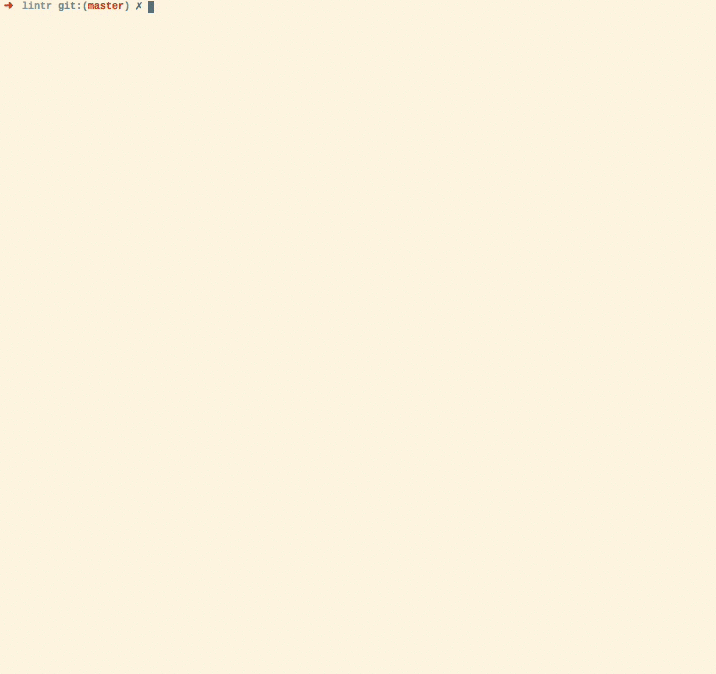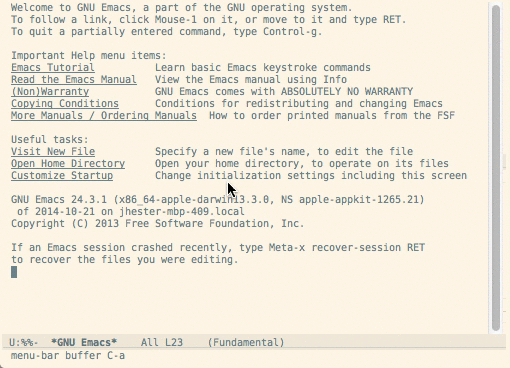lintr is an R package offering static code analysis for R. It checks adherence to a given style, syntax errors and possible semantic issues, see the animation below. In this README find out
how to configure the project to e.g. tweak checks and ignore files;
how to setup lintr for on-the-fly checking in different editors;
how to use lintr in combination with continuous integration;

lintr output?If you need a bit automatic help for re-styling your code, have a look at the styler package
Syntax errors: reported by parse.object_usage_linter: check that closures have the proper usage using codetools::checkUsage(). Note this runs base::eval() on the code, so do not use with untrusted code.absolute_path_linter: check that no absolute paths are used (e.g. “/var”, “C:\System”, “~/docs”).nonportable_path_linter: check that file.path() is used to construct safe and portable paths.pipe_continuation_linter: Check that each step in a pipeline is on a new line, or the entire pipe fits on one line.assignment_linter: check that <- is always used for assignmentcamel_case_linter: check that objects are not in camelCase.closed_curly_linter: check that closed curly braces should always be on their own line unless they are followed by an else.commas_linter: check that all commas are followed by spaces, but do not have spaces before them.commented_code_linter: check that there is no commented code outside of roxygen comments.cyclocomp_linter: check for overly complicated expressions.equals_na_linter: check for x == NAextraction_operator_linter: check that the [[ operator is used when extracting a single element from an object, not [ (subsetting) nor $ (interactive use).function_left_parentheses_linter: check that all left parentheses in a function call do not have spaces before them.implicit_integer_linter: check that integers are explicitly typed using the form 1L instead of 1.infix_spaces_linter: check that all infix operators have spaces around them.line_length_linter: check the line length of both comments and code is less than length.no_tab_linter: check that only spaces are used, never tabs.object_length_linter: check that function and variable names are not more than length characters.object_name_linter: check that object names conform to a single naming style, e.g. CamelCase, camelCase, snake_case, dotted.case, lowercase, or UPPERCASE.open_curly_linter: check that opening curly braces are never on their own line and are always followed by a newline.paren_brace_linter: check that there is a space between right parenthesis and an opening curly brace.semicolon_terminator_linter: check that no semicolons terminate statements.seq_linter: check for 1:length(...), 1:nrow(...), 1:ncol(...), 1:NROW(...), and 1:NCOL(...) expressions. These often cause bugs when the right hand side is zero. It is safer to use seq_len() or seq_along() instead.single_quotes_linter: check that only single quotes are used to delimit string constants.spaces_inside_linter: check that parentheses and square brackets do not have spaces directly inside them.spaces_left_parentheses_linter: check that all left parentheses have a space before them unless they are in a function call.todo_comment_linter: check that the source contains no TODO comments (case-insensitive).trailing_blank_lines_linter: check there are no trailing blank lines.trailing_whitespace_linter: check there are no trailing whitespace characters.T_and_F_symbol_linter: avoid the symbols T and F (for TRUE and FALSE).undesirable_function_linter: report the use of undesirable functions, e.g. options or sapply and suggest an alternative.undesirable_operator_linter: report the use of undesirable operators, e.g. ::: or <<- and suggest an alternative.unneeded_concatenation_linter: check that the c function is not used without arguments nor with a single constant.Most of the default linters are based on Hadley Wickham’s R Style Guide.
Lintr supports per-project configuration of the following fields. The config file (default file name: .lintr) is in Debian Control Field Format.
linters - see ?with_defaults for example of specifying only a few non-default linters.exclusions - a list of filenames to exclude from linting. You can use a named item to exclude only certain lines from a file.exclude - a regex pattern for lines to exclude from linting. Default is “# nolint”exclude_start - a regex pattern to start exclusion range. Default is “# nolint start”exclude_end - a regex pattern to end exclusion range. Default is “# nolint end”An example file that uses 120 character line lengths, excludes a couple of files and sets different default exclude regexs follows.
linters: with_defaults(line_length_linter(120))
exclusions: list("inst/doc/creating_linters.R" = 1, "inst/example/bad.R", "tests/testthat/exclusions-test")
exclude: "# Exclude Linting"
exclude_start: "# Begin Exclude Linting"
exclude_end: "# End Exclude Linting"With the following command, you can create a configuration file for lintr that ignores all linters that show at least one error:
# Create configuration file for lintr
# Source this file in package root directory
# List here files to exclude from lint checking, as a character vector
excluded_files <- c(
list.files("data", recursive = TRUE, full.names = TRUE),
list.files("docs", recursive = TRUE, full.names = TRUE),
list.files("inst/doc", recursive = TRUE, full.names = TRUE),
list.files("man", recursive = TRUE, full.names = TRUE),
list.files("vignettes", recursive = TRUE, full.names = TRUE)
)
### Do not edit after this line ###
library(magrittr)
library(dplyr)
# Make sure we start fresh
if (file.exists(".lintr")) { file.remove(".lintr") }
# List current lints
lintr::lint_package() %>%
as.data.frame %>%
group_by(linter) %>%
tally(sort = TRUE) %$%
sprintf("linters: with_defaults(\n %s\n dummy_linter = NULL\n )\n",
paste0(linter, " = NULL, # ", n, collapse = "\n ")) %>%
cat(file = ".lintr")
sprintf("exclusions: list(\n %s\n )\n",
paste0('"', excluded_files, '"', collapse = ",\n ")) %>%
cat(file = ".lintr", append = TRUE)
# Clean up workspace
remove(excluded_files)The resulting configuration will contain each currently failing linter and the corresponding number of hits as a comment. Proceed by successively enabling linters, starting with those with the least number of hits. Note that this requires lintr 0.3.0.9001 or later.
If you are developing a package, you can add ^\.lintr$ to your .Rbuildignore file using usethis::use_build_ignore(".lintr").
If you want to run lintr on Travis-CI in order to check that commits and pull requests don’t deteriorate code style, you will need to have Travis install the package first. This can be done by adding the following line to your .travis.yml
We recommend running lintr::lint_package() as an after_success step in your build process]
lintr-bot will then add comments to the commit or pull request with the lints found and they will also be printed on Travis-CI. If you want to disable the commenting you can set the environment variable LINTR_COMMENT_BOT=false.
Live example of a package using this setup: hibpwned, lintr-bot commenting on a PR.
To install the latest development version of lintr from GitHub
lintr lints are automatically displayed in the RStudio Markers pane, Rstudio versions (> v0.99.206). 
Install lintr, type install.packages("lintr") in the Console.
In order to show the “Markers” pane in RStudio: Menu “Tools” -> “Global Options…”, a window with title “Options” will pop up. In that window: Click “Code” on the left; Click “Diagnostics” tab; check “Show diagnostics for R”.
To lint a source file test.R type in the Console lintr::lint("test.R") and look at the result in the “Markers” pane.
This package also includes two addins for linting the current source and package. To bind the addin to a keyboard shortcut navigate to Tools > addins > Browse Addins > Keyboard Shortcuts. It’s recommended to use Alt+Shift+L for linting the current source code and Ctrl+Shift+Alt+L to code the package. These are easy to remember as you are Alt+Shift+L(int) ;)
lintr has built-in integration with flycheck versions greater than 0.23. 
lintr is fully integrated into flycheck when using ESS. See the installalation documentation for those packages for more information.
You can also configure what linters are used. e.g. using a different line length cutoff. - M-x customize-option -> flycheck-lintr-linters -> with_defaults(line_length_linter(120))
lintr can be integrated with syntastic for on the fly linting.

Put the file syntastic/lintr.vim in syntastic/syntax_checkers/r. If you are using pathogen this directory is ~/.vim/bundles/syntastic/syntax_checkers/r.
You will also need to add the following lines to your .vimrc.
let g:syntastic_enable_r_lintr_checker = 1
let g:syntastic_r_checkers = ['lintr']You can also configure what linters are used. e.g. using a different line length cutoff.
let g:syntastic_r_lintr_linters = "with_defaults(line_length_linter(120))"lintr can be integrated with Sublime Linter for on the fly linting.

Simply install sublimeLinter-contrib-lintr using Package Control.
For more information see Sublime Linter Docs
You can also configure what linters are used. e.g. disabling the assignment linter and using a different line length cutoff. In the SublimeLinter User Settings
{
"linters": {
"lintr": {
"linters": "with_defaults(assignment_linter = NULL, line_length_linter(120))"
}
}
}lintr can be integrated with Linter for on the fly linting.

Simply install linter-lintr from within Atom or on the command line with:
For more information and bug reports see Atom linter-lintr.